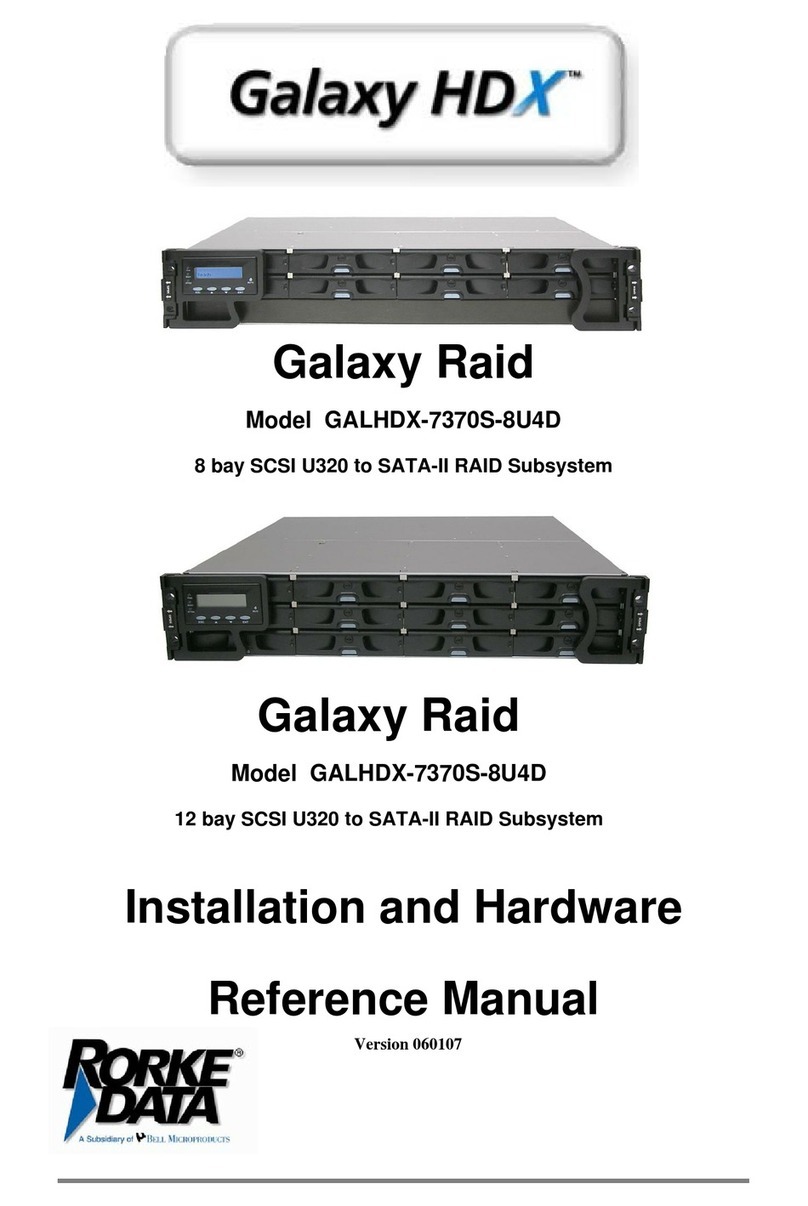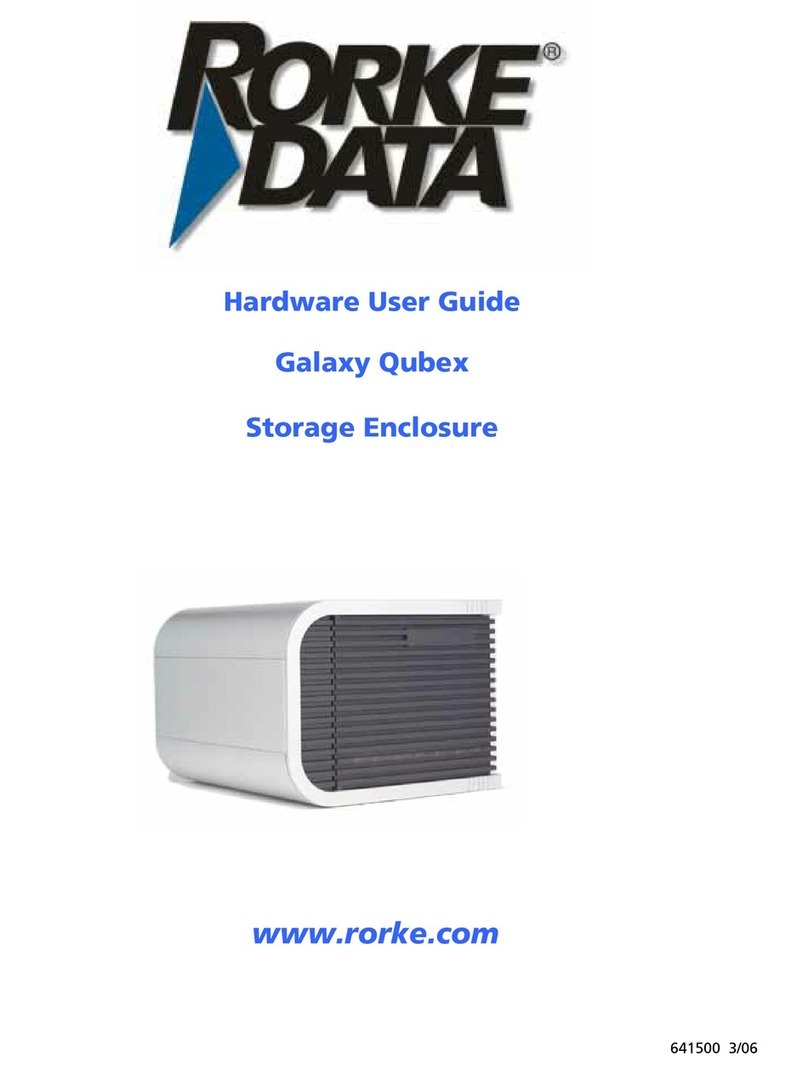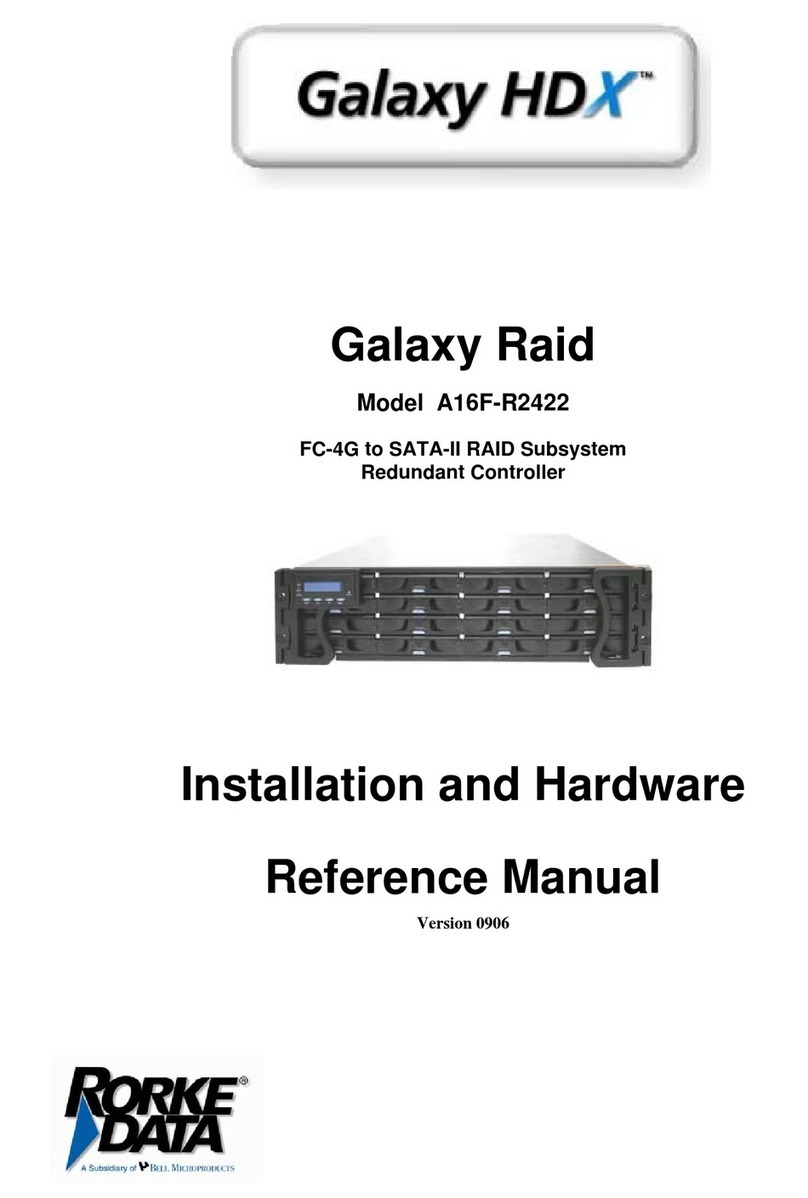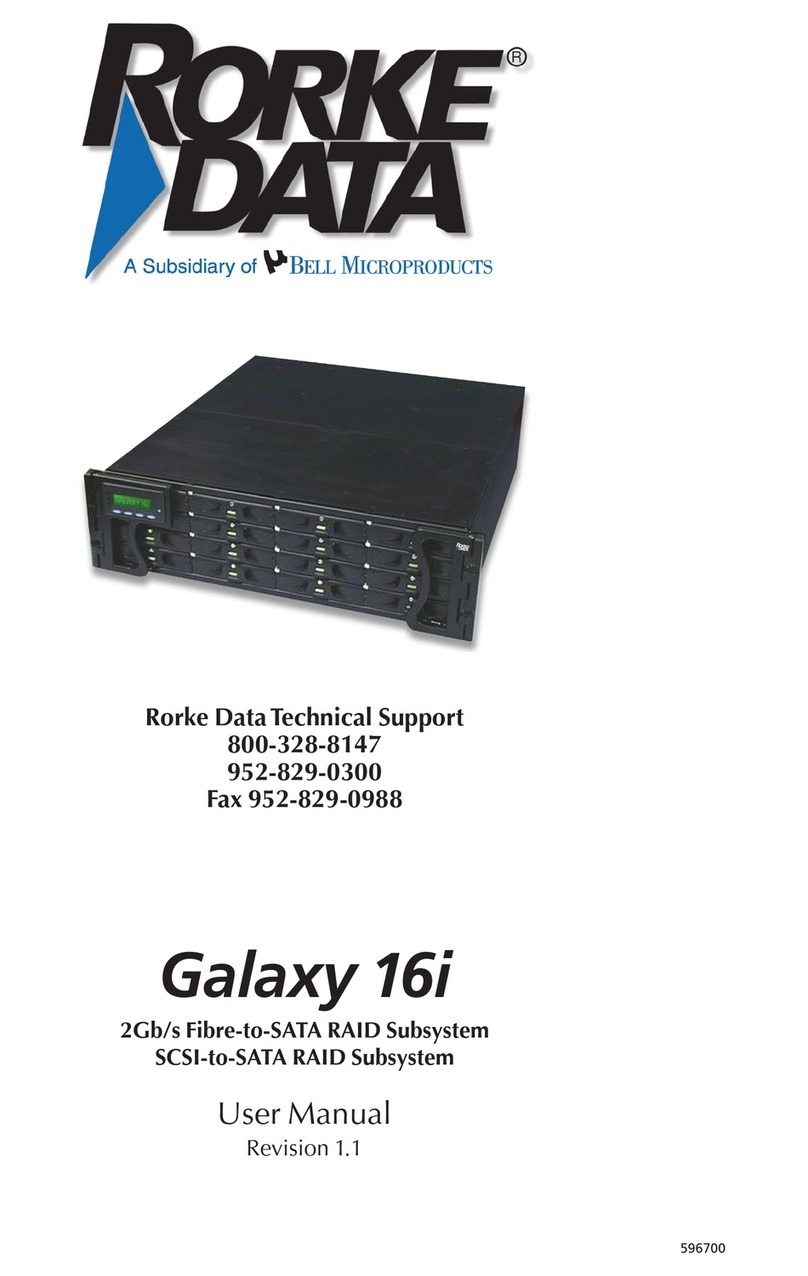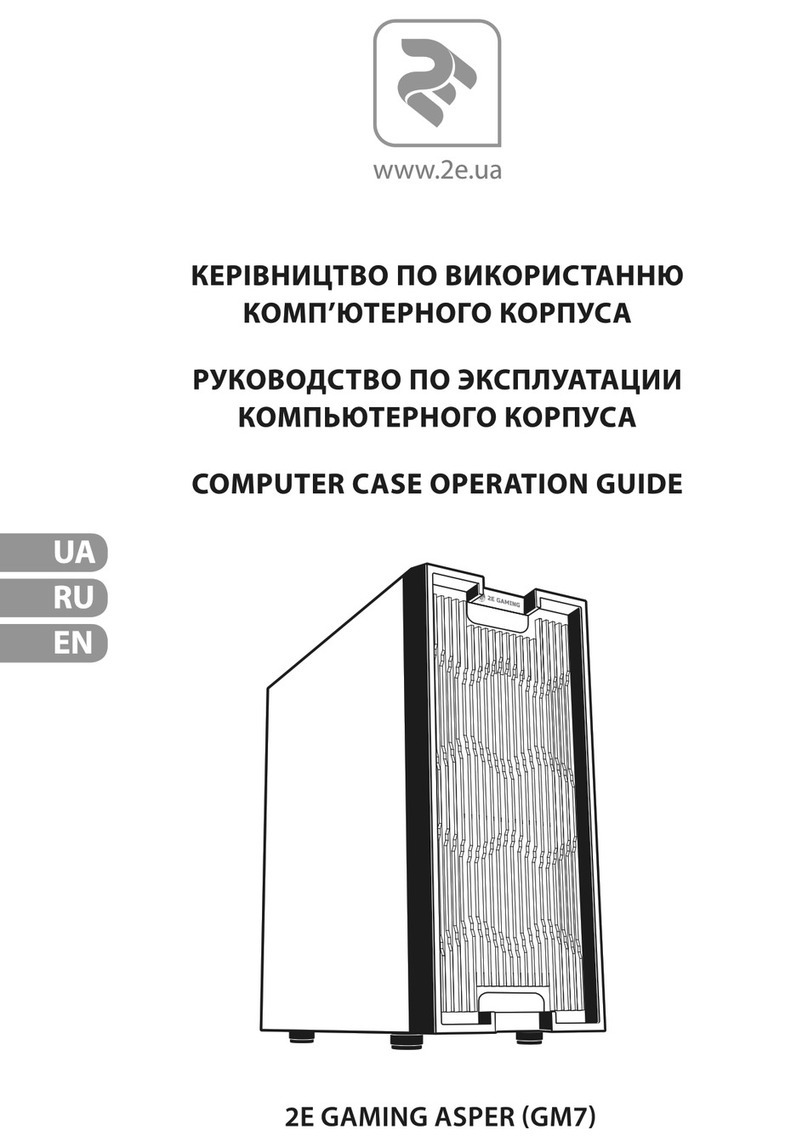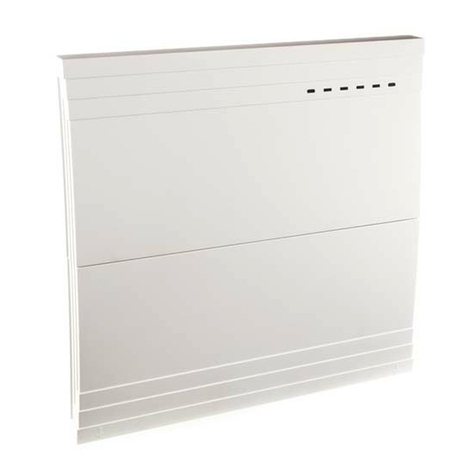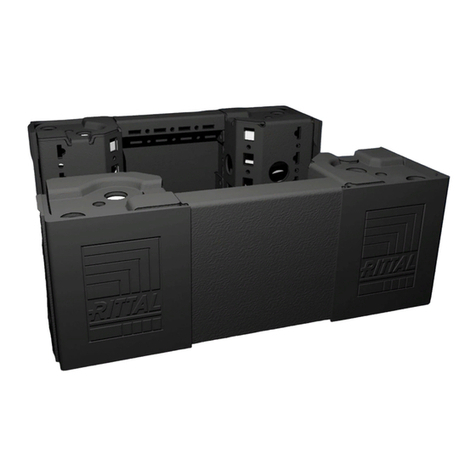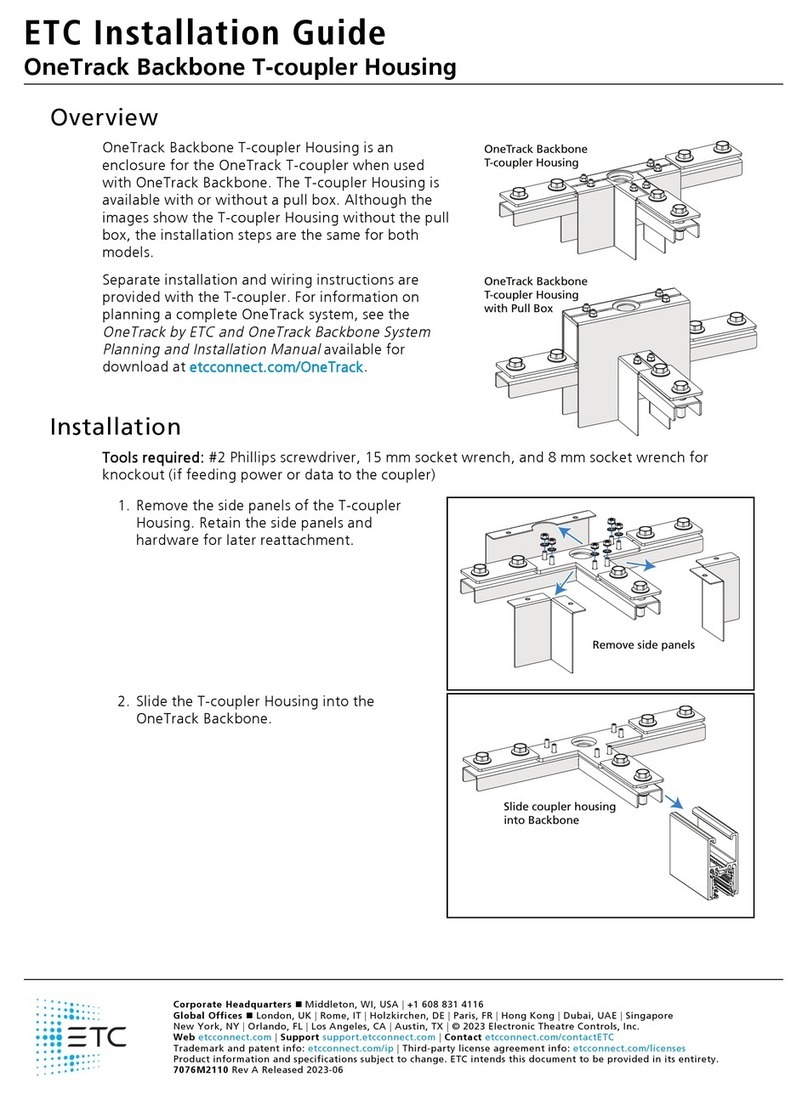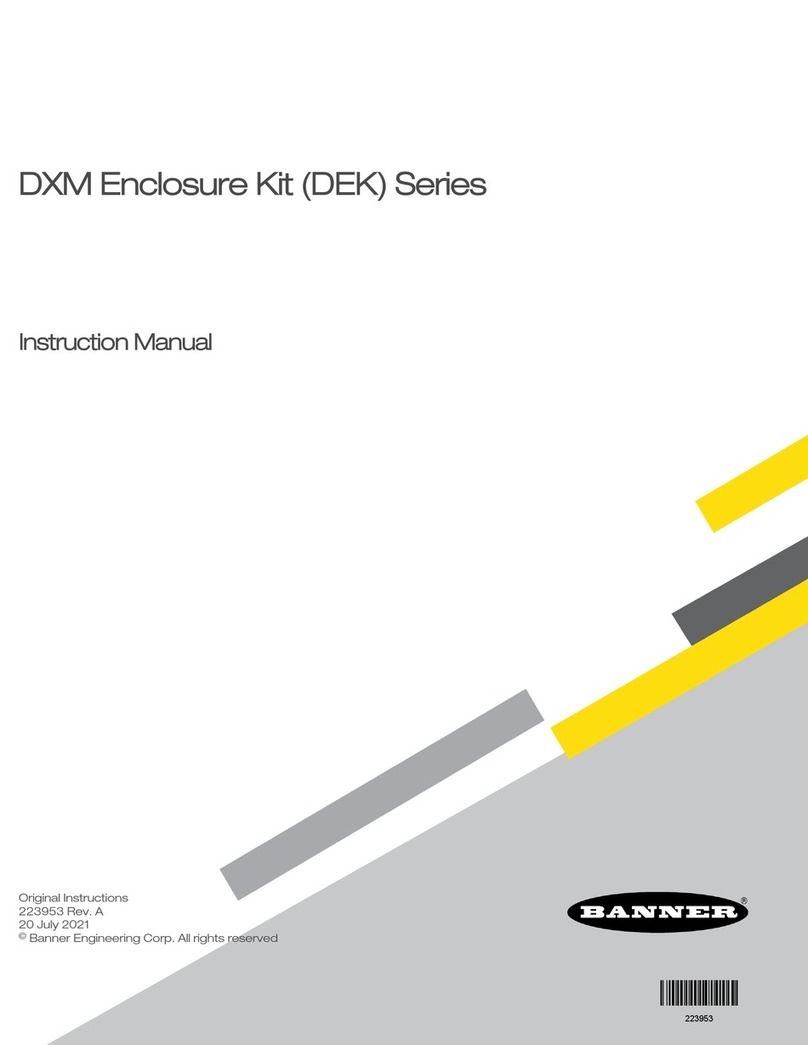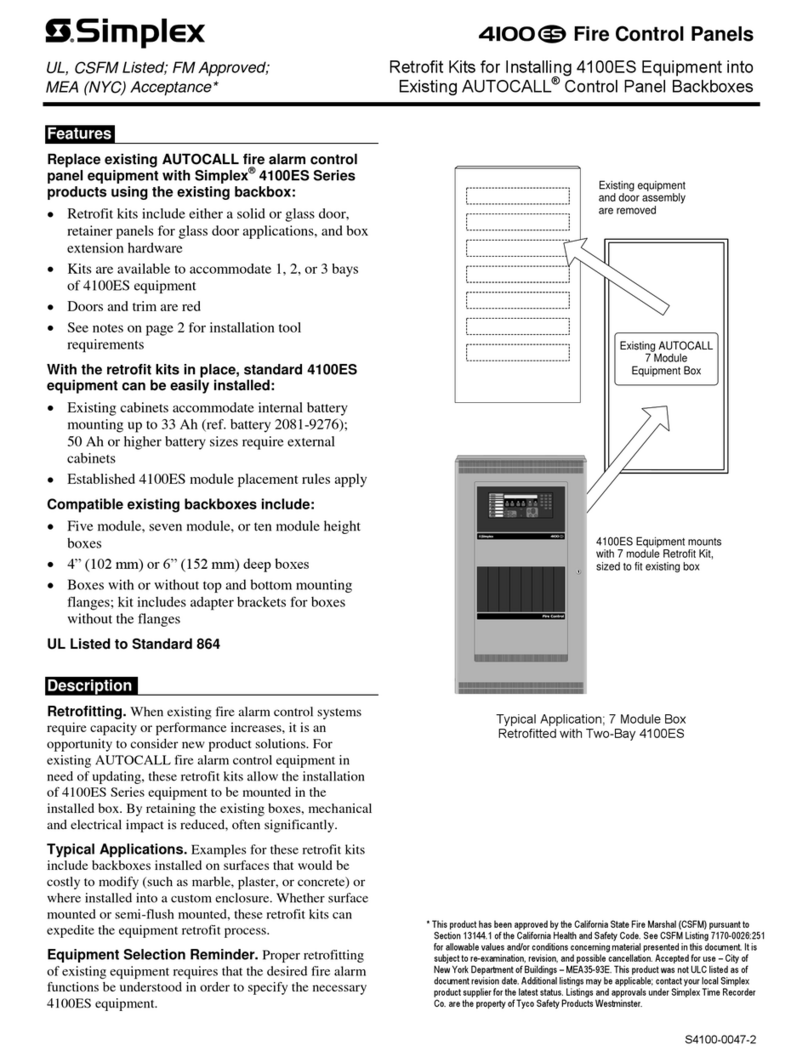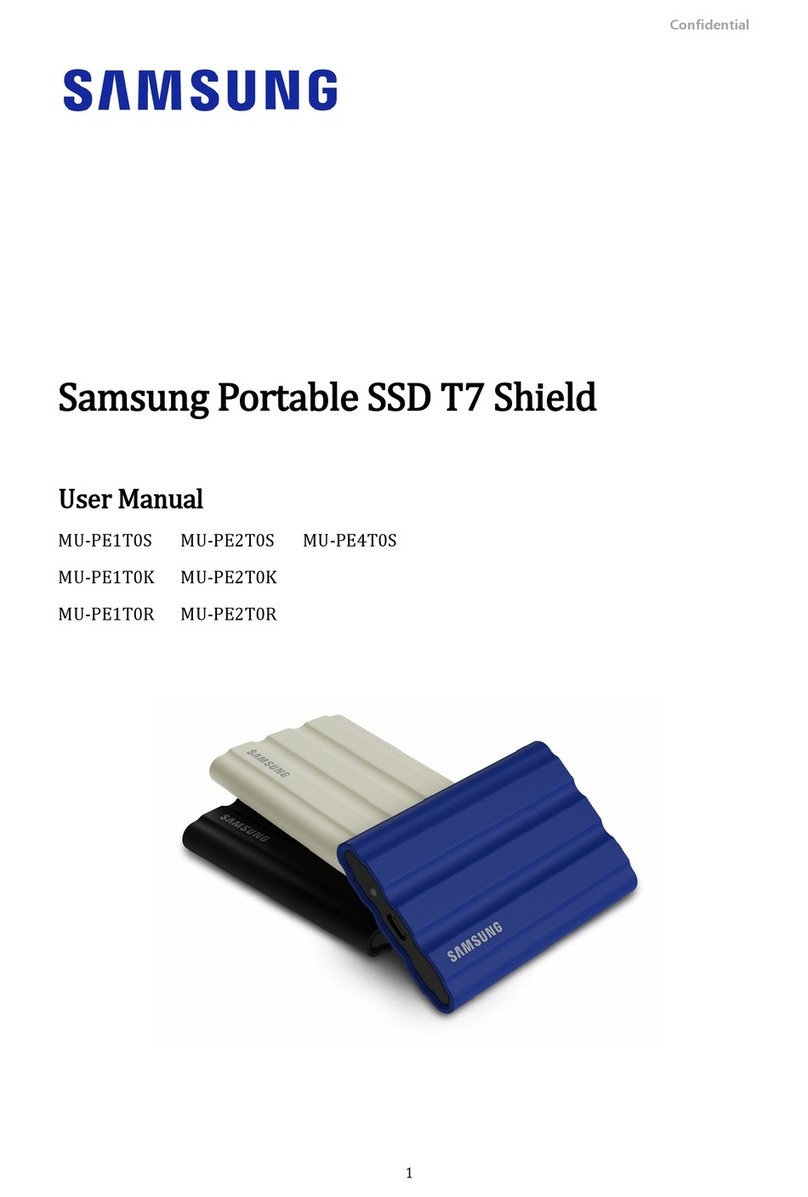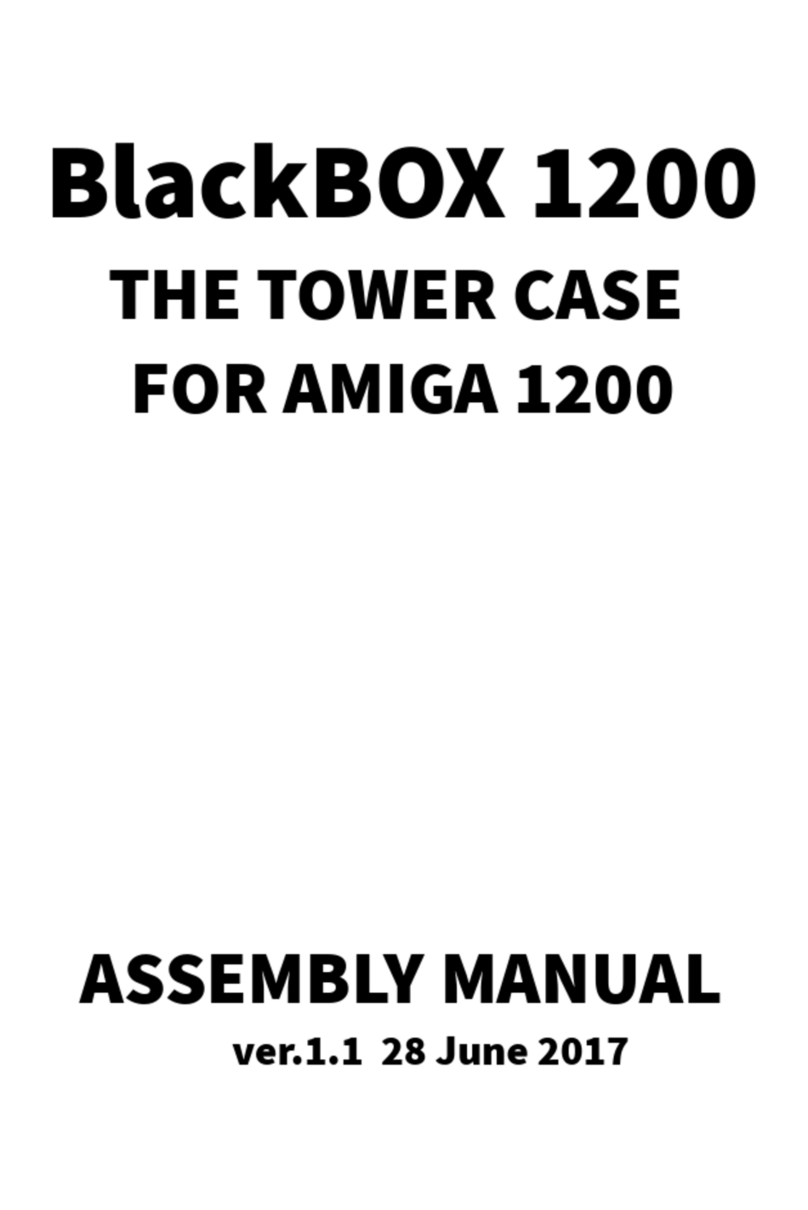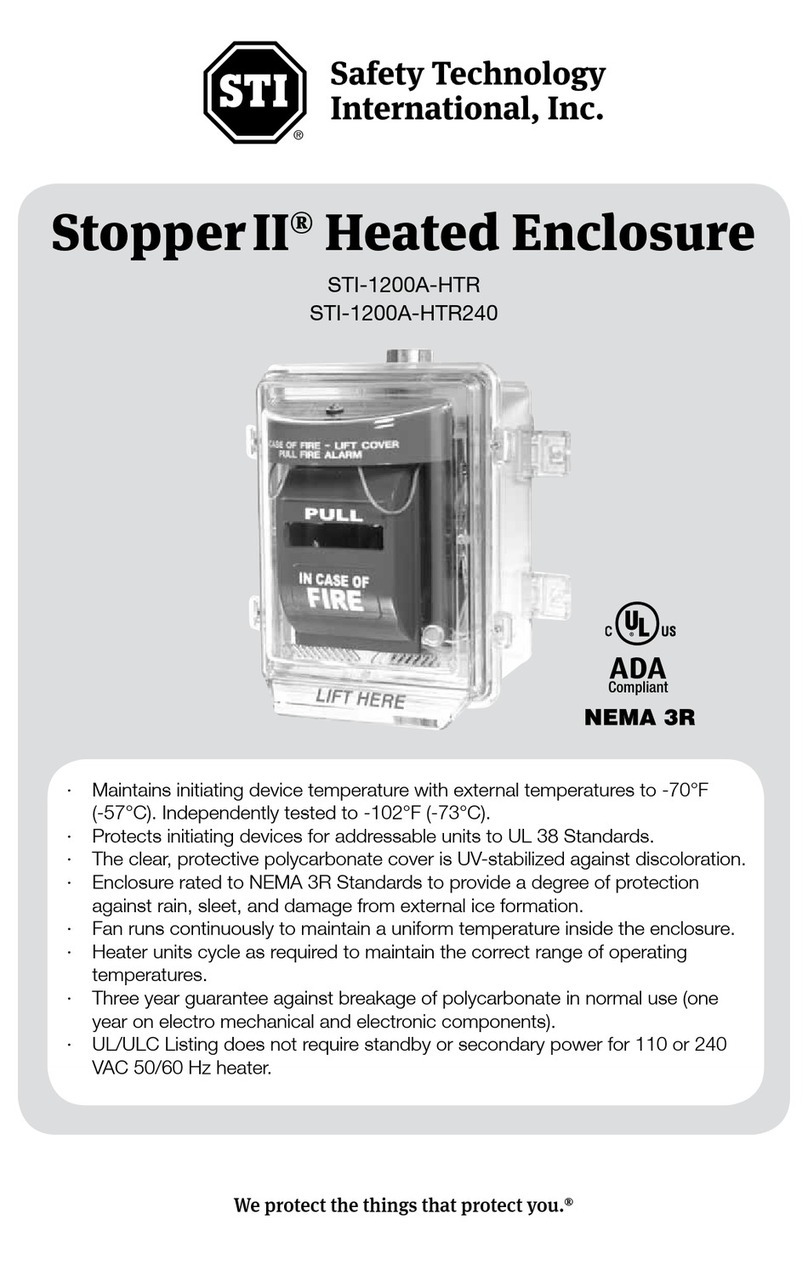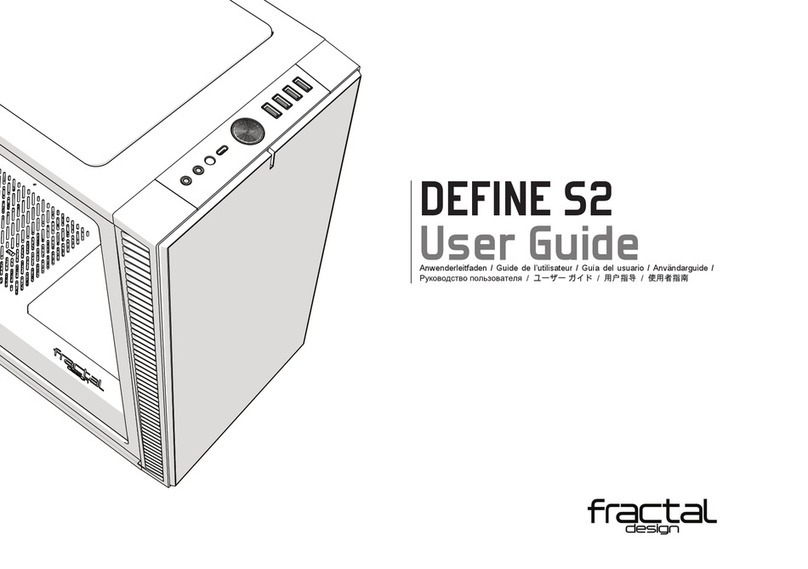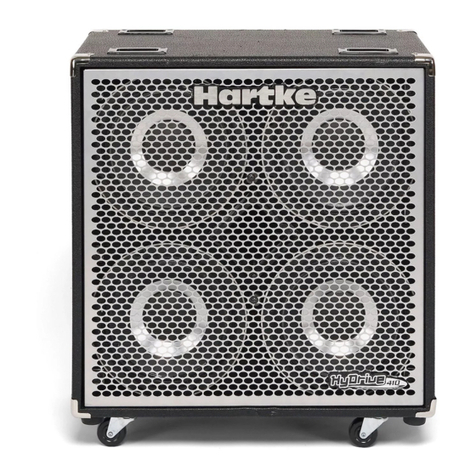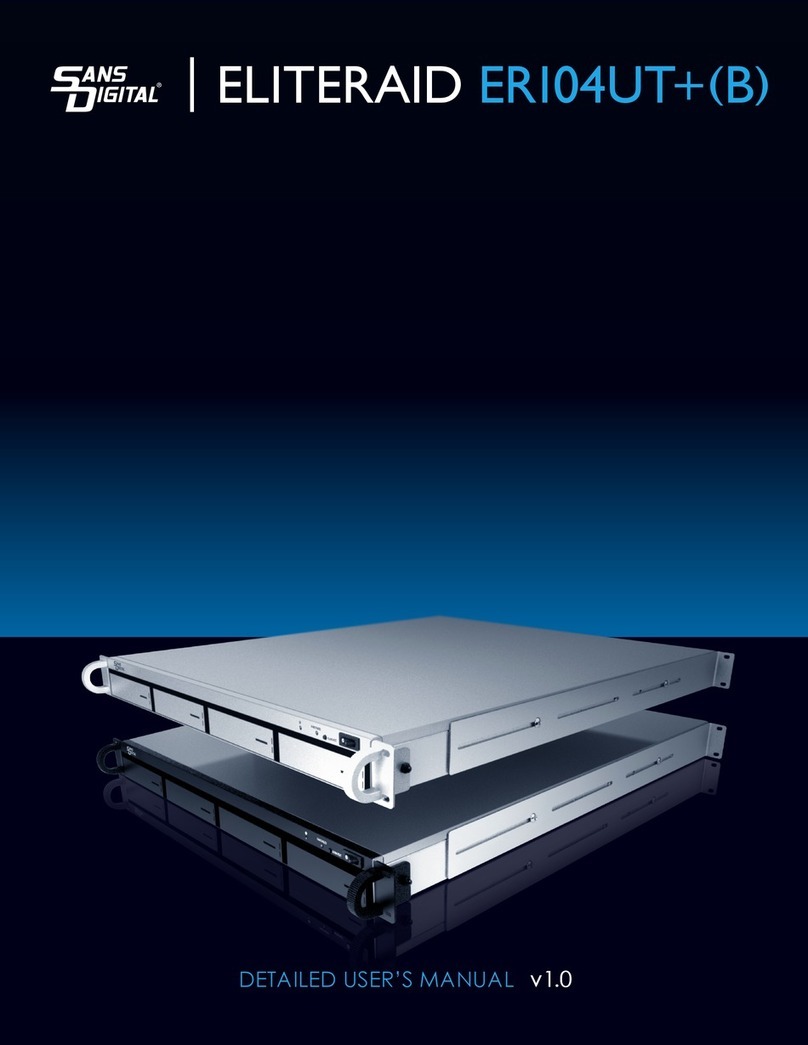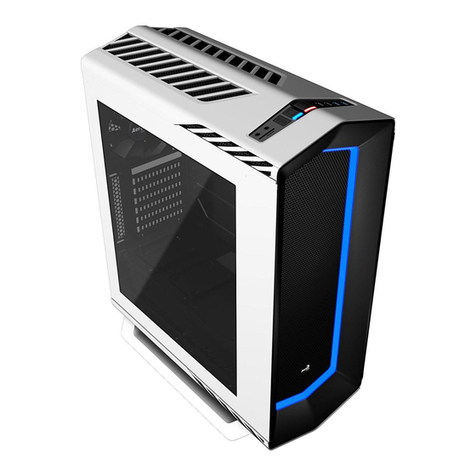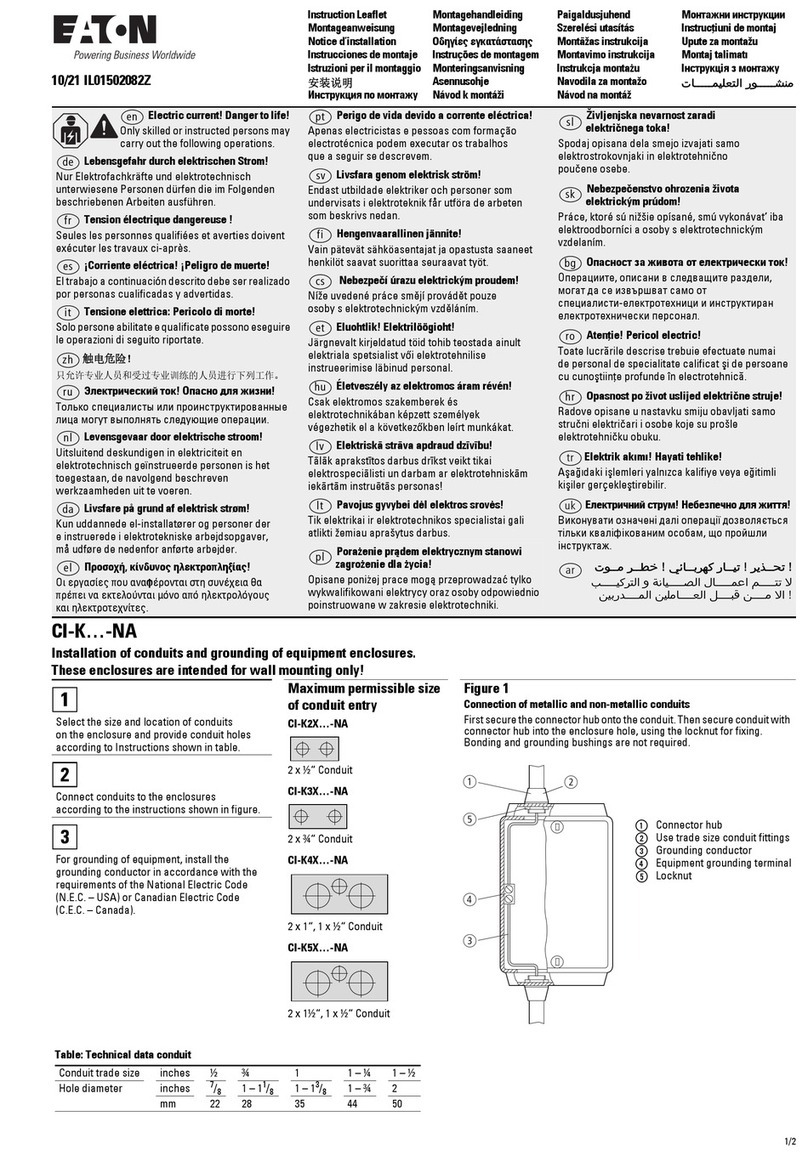Rorke Data GX4L-2240S2-12S6 User manual

Installation and Hardware
Reference Manual
ISO 9001:2008
ISO 13485:2003 Certified
www.rorke.com
Galaxy HDX4 12 Bay RAID
SAS Host SAS / SATA Drives
7th Generation Fibre Channel RAID
With over 10,000 Galaxy units in the field, Rorke Data’s award
winning RAID products provide the performance, protection,
and expansion capabilities for diverse customer environments.
PLEASE READ BEFORE INSTALLATION
MODELS:
»GX4L-2240S2-12S6
12 BAY SAS 6G to
SAS/SATA II RAID Subsystem
Single Controller
» GX4L-2240R2-12S6
12BAY SAS 6G to
SAS/SATA II RAID Subsystem
Dual Controller
Rorke Data, An Avnet Company
7626 Golden Triangle Drive, Eden Prairie, MN 55344, USA
» Toll Free 1.800.328.8147 » Phone 1.952.829.0300 » Fax 1.952.829.0988
Galaxy®HDX4
GX4L_2240_12S60411_HMN

Contact Information
Americas
Rorke Data Inc
7626 Golden Triangle Drive
Eden Prairie, MN 55344
USA
Tel: +1-800 328 8147
Fax: +1-952 829 0988
1
techsupport@rorke.com
http://www.rorke.com

Galaxy Raid GHDX4 SAS<>-SAS / SATA 12Bay Installation / Hardware Reference Manual
ii
Copyright 2010
This Edition First Published 2010
All rights reserved. This publication may not be reproduced, trans-
mitted, transcribed, stored in a retrieval system, or translated into any
language or computer language, in any form or by any means, elec-
tronic, mechanical, magnetic, optical, chemical, manual or otherwise,
without the prior written consent of Rorke Data, Inc.
Disclaimer
Rorke Technology makes no representations or warranties with res-
pect to the contents hereof and specifically disclaims any implied
warranties of merchantability or fitness for any particular purpose.
Furthermore, Rorke Data reserves the right to revise this publication
and to make changes from time to time in the content hereof without
obligation to notify any person of such revisions or changes. Product
specifications are also subject to change without prior notice.
Trademarks
Galaxy and the Galaxy logo are registered trademarks of Rorke
Data, Inc.
Solaris and Java are trademarks of Sun Microsystems, Inc.
All other names, brands, products or services are trademarks or
registered trademarks of their respective owners.

Galaxy Raid Installation and Hardware Reference Manual
iii
Warnings and Certifications
RESTRICTED ACCESS LOCATION:
This equipment is intended to be installed in a RESTRICTED ACCESS
LOCATION only.
Access can only be gained by SERVICE PERSONS or by USERS
who have been instructed about the reasons for the restrictions
applied to the location and about any precautions that shall be
taken; and
Access is by an authorized person through the use of a TOOL or
lock and key, or other means of security, and is controlled by the
authority responsible for the location.
ELECTRIC SHOCK WARNING!
To Prevent Electric Shock:
1. Access to this equipment is granted only to trained operators and
service personnel who have been instructed of and fully understand
the possible hazardous conditions and the consequences of accessing
non-field-serviceable units, e.g., system backplane or power supplies.
2. Unplug the system before you move it or when it has become
damaged.
RELIABLE EARTHING!
Particular attention should be given to prepare reliable earthing with the
power supply connections other than direct connections to the branch circuit
(e.g., use of power strips). The AC power cords provide the main earth
connection. Check proper grounding before powering on the enclosure.
OVERLOADING PROTECTION!
1. The enclosure should be installed according to specifications on a
chassis label. Provide a suitable power source with electrical overload
protection.
2. Do not overload the AC supply branch circuit that provides power to the
rack. The total rack load should not exceed 80 percent of the branch
circuit rating.
BATTERY USE WARNING!
Risk of explosion if battery is replaced by an incorrect type. Dispose of used
batteries according to local ordinance.

Galaxy Raid GHDX4 SAS<>-SAS / SATA 12Bay Installation / Hardware Reference Manual
iv
THERMAL PRECAUTIONS:
1. If installed in a closed or multi-unit rack assembly, the operating ambient
temperature of the rack environment may be greater than room ambient.
Appropriate measures, such as increasing airflow, should be available
to maintain the temperature below 35°C.
2. The openings on the enclosure are for air convection. DO NOT COVER
THE OPENINGS.
3. To comply with safety, emission, and thermal requirements, all module
bays should be populated with plug-in modules. The system should not
be operated with the absence of any covers.
HANDLING PRECAUTIONS:
1. The system can either be installed into a standard EIA-310 19” rack
cabinet or placed on a desktop. Mechanical loading of the enclosure
should be carefully handled to avoid hazardous condition. A drop or fall
could cause injury.
2. Lay this system on a reliable surface with desktop installation. A drop or
fall can cause injury.
3. Mounting this enclosure requires two people.
4. The enclosure can weigh up to 37Lbs (17kg) without disk drives. With
disk drives loaded, the enclosure can weigh up to 60lb (24kg). A reliable
surface should be available to support this weight.
5. Disk drives should be installed after the enclosure is securely installed.

Galaxy Raid Installation and Hardware Reference Manual
v
FCC (applies in the U.S. and Canada)
FCC Class A Radio Frequency Interference Statement
This device complies with Part 15 of the FCC rules. Operation is
subject to the following two conditions: (1) this device may not cause
harmful interference, and (2) this device may accept any interference
received, including interference that may cause undesired operation.
NOTE:
This equipment has been tested and found to comply with the limits
for a Class A digital device, pursuant to Part 15 of the FCC Rules.
These limits are designed to provide reasonable protection against
harmful interference when the equipment is operated in a commercial
environment. This equipment generates, uses, and can radiate radio
frequency energy and, if not installed and used in accordance with
the instruction manual, may cause harmful interference to radio
communications. Operation of this equipment in a residential area is
likely to cause harmful interference in which case the user will be
required to correct the interference at his own expense.
Any changes or modifications not expressly approved by the party
responsible for compliance could void the user’s authority to operate
the equipment.
WARNING:
A shielded power cord is required in order to meet FCC emission
limits and also to prevent interference to nearby radio and television
reception.
Use only shielded cables to connect I/O devices to this equipment.
You are cautioned that changes or modifications not expressly
approved by the party responsible for compliance could void your
authority to operate the equipment.
This device is in conformity with the EMC.
CB
(Certified Worldwide)
This device meets the requirements of the CB standard for
electrical equipment with regard to establishing a satisfactory
level of safety for persons using the device and for the area
surrounding the apparatus. This standard covers only safety
aspects of the above apparatus; it does not cover other
matters, such as style or performance.

Galaxy Raid GHDX4 SAS<>-SAS / SATA 12Bay Installation / Hardware Reference Manual
vi
CCC
For Power Supplies’ compatibility to China Compulsory
Certification.
China RoHS
In Compliance with AeA China RoHS Regulations (SJ/T 11364-2006)
ITE BSMI Class A,
CNS 13438
(for Taiwan)
This device is in conformity with UL standards for safety.
Инструкция по безопасности
Модель:
FC to SAS/SATA 3U/16, 4U/24 Bay RAID Subsystem, Models, where “x” can
be “0-9”, “A-Z“, blank, or dash “x” for marketing purpose and no impact safety
related critical components and constructions.
1. Перед использованием оборудования внимательно прочтите
инструкцию.
2. Сохраняйте инструкцию для дальнейшего использования в работе.
3. Не допускайте попадания влаги на изделие.
4. Устанавливайте оборудование на устойчивую поверхность.
Падение может нанести ущерб оборудованию.
5. Соблюдайте климатические требования, использование
оборудование при температуре окружающей среды выше 50°С,
может привести к выходу оборудования из строя.
6. Размещайте шнур питания в недоступном для пользователя месте.
Запрещается ставить на шнур питания какие-либо предметы.
7. При работе с оборудованием необходимо учитывать все
предупреждения и замечания.
8. Если оборудование не используется в течении длительного времени,
отключите его от сети питания.
9. Запрещается вскрывать оборудование. Оборудование может

Galaxy Raid Installation and Hardware Reference Manual
vii
вскрываться только квалифицированным персоналом.
10. При возникновении одного из повреждений оборудования вызовите
обслуживающий персонал:
a.Повреждение шнура питания или вилки.
b.Оборудование не работает или его работа не соответствует
инструкции пользователя .
e.Оборудование повреждено.
f. Оборудование имеет очевидный признак поломки.
11. Источник питания должен быть установлен в соответствии с
инструкцией. Ток нагрузки и выходная мощность не должны
превышать указанных в спецификации.
Rorke is committed to being properly prepared and taking all
the necessary steps that will result in our compliance with the
new European directive, RoHS (2002/95/EC), on or before
the specific dates set forth in those applicable laws and
regulations. Rorke is applying its own internal efforts and
expertise and is working closely with customers and suppliers
to achieve compliance while maintaining an uninterrupted
supply of quality products. Rorke is currently investigating,
evaluating, and qualifying our materials and components to
ensure that products sold on or after 1 July 2006, in such
territory, are in compliance with the above regulations.
Disposal of Old Electrical & Electronic Equipment (Applicable
in the European Union and other European countries with
separate collection systems)
This symbol on the product or on its packaging indicates that
this product shall not be treated as household waste. Instead
it shall be handed over to the applicable collection point for
the recycling of electrical and electronic equipment. By proper
waste handling of this product you ensure that it has no
negative consequences for the environment and human
health, which could otherwise be caused if this product is
thrown into the garbage bin. The recycling of materials will
help to conserve natural resources.
For more details about recycling of this product, please
contact your local city office, your household waste disposal
service or the shop where you purchased the product.

Galaxy Raid GHDX4 SAS<>-SAS / SATA 12Bay Installation / Hardware Reference Manual
viii
Table of Contents
CONTACT INFORMATION..........................................................................................................I
COPYRIGHT 2010 ....................................................................................................................II
This Edition First Published 2010 ........................................................................................ii
Disclaimer ii
Trademarks ......................................................................................................................... ii
Warnings and Certifications................................................................................................ iii
SAFETY PRECAUTIONS ........................................................................................................ VIII
Precautions and Instructions .............................................................................................viii
ESD Precautions ................................................................................................................ix
ABOUT THIS MANUAL ......................................................................................................... IXI
REVISION HISTORY .............................................................................................................. XII
WHO SHOULD READ THIS MANUAL?..................................................................................... XII
Related Documentation..................................................................................................... xii
CONVENTIONS...................................................................................................................... XII
Notes xi
SOFTWARE AND FIRMWARE UPDATES ................................................................................ XIII
CHAPTER 1 INTRODUCTION
1.1 PRODUCT OVERVIEW..................................................................................................1-1
1.1.1 Introduction........................................................................................................1-1
1.1.2 Enclosure Chassis.............................................................................................1-2
1.2 SYSTEM COMPONENTS ...............................................................................................1-5
1.2.1 Drive Tray..........................................................................................................1-5
1.2.2 The RAID Controller Module .............................................................................1-5
1.2.3 Controller Module Interfaces .............................................................................1-6
1.2.4 Cache Module...................................................................................................1-7
1.2.5 CBM (Optional Feature)....................................................................................1-7
1.2.6 Power Supply Units...........................................................................................1-9
1.2.7 Cooling Modules..............................................................................................1-10
1.3 SYSTEM MONITORING ...............................................................................................1-10
1.3.1 I2C bus............................................................................................................1-10
1.3.2 LED Indicators.................................................................................................1-10
1.3.3 Audible Alarms................................................................................................1-11
1.4 HOT-SWAPPABLE COMPONENTS.................................................................................1-11
1.4.1 Hot-swap Capabilities......................................................................................1-11
1.4.2 Components....................................................................................................1-12
1.4.3 Normalized Airflow ..........................................................................................1-12
CHAPTER 2 HARDWARE INSTALLATION
2.1 INTRODUCTION ...........................................................................................................2-1
2.2 INSTALLATION PREREQUISITES.....................................................................................2-1
2.3 SAFETY PRECAUTIONS................................................................................................2-3
2.3.1 Precautions and Instructions.............................................................................2-3
2.3.2 Static-free Installation........................................................................................2-7
2.4 GENERAL INSTALLATION PROCEDURE...........................................................................2-7
Installation Procedure Flowchart ......................................................................................2-7
2.5 UNPACKING THE SYSTEM ............................................................................................2-8
2.5.1 Preinstalled Components................................................................................2-10
2.5.2 Modules to be Installed.......................................................................................2-10
2.6 RACK/CABINET INSTALLATION....................................................................................2-10
Removing Chassis..........................................................................................................2-17
2.7 CONTROLLER INSTALLATION ......................................................................................2-17
2.7.1 Installing a Controller Module..........................................................................2-17
2.8 HARD DRIVE INSTALLATION........................................................................................2-18
2.8.1 Hard Drive Installation Prerequisites...................................................................2-18
2.8.2 Drive Installation.................................................................................................2-19
2.9 DRIVE TRAY INSTALLATION ........................................................................................2-20
2.10 INSTALLING CBM(OPTIONAL)...................................................................................2-22

Galaxy Raid Installation and Hardware Reference Manual
ix
CHAPTER 3 SYSTEM CONNECTIONS
3.1 HOST CONNECTION PREREQUISITES ............................................................................3-1
3.1.1 Host Link Cables................................................................................................3-1
3.1.2 Other Considerations.........................................................................................3-2
3.2 SAMPLE TOPOLOGY....................................................................................................3-4
3.3 EXPANSION LINKS.......................................................................................................3-6
3.4 CONNECTING OTHER INTERFACES................................................................................3-8
3.5 CONNECTING POWER CORDS ......................................................................................3-9
3.6 POWER ON..............................................................................................................3-10
Check List 3-10
Power On Procedure......................................................................................................3-11
Power On Status Check .................................................................................................3-12
LCD Screen....................................................................................................................3-12
3.7 POWER OFF PROCEDURE..........................................................................................3-14
CHAPTER 4 SYSTEM MONITORING
4.1 OVERVIEW .................................................................................................................4-1
4.2 STATUS-INDICATING LEDS..........................................................................................4-3
4.2.1 LED Overview ...................................................................................................4-3
4.2.2 LCD Keypad Panel............................................................................................4-3
4.2.3 Drive Tray LEDs................................................................................................4-4
4.2.4 Controller Module LEDs ....................................................................................4-5
How to Use the Restore Default Button?..........................................................................4-7
4.2.5 PSU LEDs.......................................................................................................4-10
4.2.6 Cooling Module LEDs......................................................................................4-10
4.3 AUDIBLE ALARM .......................................................................................................4-11
4.3.1 Overview.........................................................................................................4-11
4.3.2 Alarm Triggers.................................................................................................4-12
4.3.3 I2C 4-12
CHAPTER 5 SYSTEM MAINTENANCE
5.1. OVERVIEW .................................................................................................................5-1
5.1.1 Maintenance......................................................................................................5-1
5.1.2 General Notes on Component Replacement.....................................................5-2
5.2. REPLACING A CONTROLLER MODULE............................................................................5-3
5.2.1 Overview...........................................................................................................5-3
5.2.2 Notes on Controller Maintenance......................................................................5-3
5.2.3 Removing a Controller Module..........................................................................5-3
5.2.4 Replacing the Controller Module.......................................................................5-5
5.3. REPLACING OR UPGRADING MEMORY MODULES............................................................5-6
5.3.1 Installation Overview.........................................................................................5-6
5.3.2 Selecting the Memory Modules.........................................................................5-6
5.3.3 DIMM Module Installation..................................................................................5-6
5.4. REPLACING A FAULTY CBM.........................................................................................5-7
5.4.1 BBU Fault Conditions:.......................................................................................5-7
5.4.2 BBU Warnings and Precautions........................................................................5-8
5.4.3 Replacing a Faulty BBU....................................................................................5-9
5.4.4 Replacing a Faulty Flash Backup Module.......................................................5-10
5.5. REPLACING A FAULTY PSU .......................................................................................5-11
5.5.1 Notes on PSU Module Maintenance ...............................................................5-11
5.5.2 Replacing the PSU Module .............................................................................5-11
5.6. COOLING MODULE MAINTENANCE ..............................................................................5-13
5.6.1 Notes on Cooling Module Maintenance...........................................................5-13

Galaxy Raid GHDX4 SAS<>-SAS / SATA 12Bay Installation / Hardware Reference Manual
x
5.6.2 Replacing a Cooling Module............................................................................5-14
5.7. REPLACING A HARD DRIVE ........................................................................................5-15
5.7.1 Hard Drive Maintenance Overview..................................................................5-15
5.7.2 Replacing a Hard Drive...................................................................................5-16
APPENDIX A SPECIFICATIONS
A.1 TECHNICAL SPECIFICATIONS.......................................................................................A-1
A.2 CONTROLLER SPECIFICATIONS....................................................................................A-3
A.3 POWER SUPPLY SPECIFICATIONS................................................................................A-4
A.4 RAID MANAGEMENT..................................................................................................A-5
A.5 FAULT TOLERANCE MANAGEMENT...............................................................................A-5
APPENDIX B PINOUTS
B.1 SAS CONNECTOR PINOUTS.......................................................................................B-1
B.2 COM1 SERIAL PORT CABLE......................................................................................B-2
B.3 ETHERNET PORT PINOUTS ........................................................................................B-3
B.4 POWER CONNECTORS...............................................................................................B-3
Safety Precautions
Precautions and Instructions
•Prior to powering on the subsystem, ensure that the correct power range
is being used.
•If it is necessary to transport the subsystem, repackage all disk drives
separately in the drive trays and in the original package foam blocks. If
using the original package material, other replaceable modules can stay
within the enclosure.
•The Galaxy subsystems come with 12, 16, or 24 drive bays. Leaving any
of these drive bays empty will greatly affect the efficiency of the airflow
within the enclosure, and will consequently lead to the system
overheating, which can cause irreparable damage.
•If a module fails, leave it in place until you have a replacement unit and
you are ready to replace it.
•Airflow Consideration: The subsystem requires an airflow clearance,
especially at the front and rear. A clearance of at least 18 to 20
centimeters is required at the rear side and any objects blocking the
exhaust airflow, e.g., cables dangling at the fan outlet, should be avoided.
•Handle subsystem modules using the retention screws, eject levers, and
the metal frames/face plates. Avoid touching PCB boards and connector
pins.

Galaxy Raid Installation and Hardware Reference Manual
xi
•To comply with safety, emission, or thermal requirements, none of the
covers or replaceable modules should be removed. Make sure that all
enclosure modules and covers are securely in place during operation.
•Be sure that the rack cabinet into which the subsystem chassis will be
installed provides sufficient ventilation channels and airflow circulation
around the subsystem.
•Provide a soft, clean surface to place your subsystem on before working
on it. Servicing on a rough surface may damage the exterior of the
chassis.
•If it is necessary to transport the subsystem, repackage all drives
separately.
•Dual-redundant controller models come with two RAID controllers that
should always be present. Single-controller models come with a single
RAID controller and a metal sheet is placed over the lower controller bay
at the rear of the subsystem. Since single-controller models cannot be
upgraded, this metal sheet should NEVER be removed.
ESD Precautions
Observe all conventional anti-ESD methods while handling system
modules. The use of a grounded wrist strap and an anti-static work
pad are recommended. Avoid dust and debris in your work area.
About This Manual
This manual:
Introduces the Galaxy storage system series.
Describes all major components in the system.
Provides recommendations and details about the hardware
installation process.
Describes how to monitor system operating statuses.
Describes how to maintain the subsystem.
This manual does not:
Describe components that are not user-serviceable.

Galaxy Raid GHDX4 SAS<>-SAS / SATA 12Bay Installation / Hardware Reference Manual
xii
Give a detailed description of the RAID processing units or the
RAID controllers within the subsystem.
Revision History
Rev. 1.0: Initial release.
Who should read this manual?
This manual assumes that its readers are experienced with computer
hardware installation and are familiar with storage enclosures.
Related Documentation
•Generic Operation Manual (firmware operation via LCD keypad
and terminal emulation)
These documents are included in the product utility CD that came
with your subsystem package.
Conventions
Naming
From this point on and throughout the rest of this manual, the Galaxy
series is referred to as simply the “subsystem” or the “system” and
Rorke is sometimes abbreviated as “Gal.”
Important Messages
Important messages appear where mishandling of components is
possible or when work order can be mis-conceived. These
messages also provide important information associated with other
aspects of system operation. The word “important” is written as
“IMPORTANT,” both capitalized and bold and is followed by text in
italics. The italicized text is the message to be delivered.
Warnings
Warnings appear where overlooked details may cause damage to the
equipment or result in personal injury. Warnings should be taken
seriously. Warnings are easy to recognize. The word “warning” is
written as “WARNING,” both capitalized and bold and is followed by
text in italics. The italicized text is the warning message.
Cautions

Galaxy Raid Installation and Hardware Reference Manual
xiii
Cautionary messages should also be heeded to help you reduce the
chance of losing data or damaging the system. Cautions are easy to
recognize. The word “caution” is written as “CAUTION,” both
capitalized and bold and is followed by text in italics. The italicized
text is the cautionary message.
Notes
These messages inform the reader of essential but non-critical
information. These messages should be read carefully as any
directions or instructions contained therein can help you avoid
making mistakes. Notes are easy to recognize. The word “note” is
written as “NOTE,” both capitalized and bold and is followed by text
in italics. The italicized text is the cautionary message.
Lists
Bulleted Lists: Bulleted lists are statements of non-sequential facts.
They can be read in any order. Each statement is preceded by a
round black dot “•.”
Numbered Lists:Numbered lists are used to describe sequential
steps you should follow in order.
Software and Firmware Updates
Please contact your system vendor or contact Rorke’s technical
support techsupport@rorke.com for the latest software or firmware
updates. NOTE that the firmware version installed on your system
should provide the complete functionality listed in the specification
sheet/user’s manual. We provide special revisions for various
application purposes. Therefore, DO NOT upgrade your firmware
unless you fully understand what a firmware revision will do.
Problems that occur during the updating process may cause
irrecoverable errors and system down time. Always consult technical
personnel before proceeding with any firmware upgrade.

Galaxy Raid GHDX4 SAS<>-SAS / SATA 12Bay Installation / Hardware Reference Manual
xiv
This page is intentionally left blank.

Chapter 1
Introduction
1.1 Product Overview
1.1.1 Introduction
This hardware manual briefly introduces the Galaxy® HDX4 SAS to
SAS / SATA RAID subsystem. The 12-bay model comes with two (2)
6Gb/s SAS host channels and supports twelve (12) hot-swappable
6Gb/s SAS or 3Gb/s SATA hard drives in a 2U chassis. The core of
the subsystem is the RAID controller module powered by a 6th-
generation ASIC667
RAID engine. By default,
each RAID controller
comes with a pre-
installed 1GB DDRII
RAM DIMM module.
Each SAS channel is
capable of a 2400MB/s bandwidth. With a passive backplane,
redundant hot-swappable component design, and sophisticated
firmware, the subsystem is ideal for high availability applications.
The enclosure is designed to contain twelve (12) 3.5-inch disk drives.
Drive capacity can be expanded by attaching a maximum of six (6)
2U-profile expansion drive enclosures, adding 72 more disk drives.
Two (2) cooling modules protect the subsystem from overheating,
and two (2) hot-swappable power supply unit (PSU) modules provide
constant power to the subsystem. The modular nature of the
subsystem and the easy accessibility to all major components ensure
ease of maintenance.
Galaxy HDX4 12bay RAID System

Galaxy Raid GHDX4 SAS<>SAS / SATA 12Bay Installation / Hardware Reference Manual
1-2
NOTE:
After receiving
your subsystem, please check the package
contents against the included Unpacking List. If any module is
missing, please contact your subsystem vendor immediately.
1.1.2 Enclosure Chassis
1.1.2.1 Chassis Overview
The subsystem chassis is an enhanced 2U storage chassis divided
into front and rear sections, which are respectively accessed through
front and rear panels. The enclosure is designed to be installed into a
rack or cabinet. Read the following sections for the components’
descriptions and locations in the subsystem.
NOTE:
Components accessed through the front panel are referred to as
“Front Panel Components” and components accessed through
the rear panel are referred to as “Rear Panel Components.”
1.1.2.2 Physical Dimensions
The Galaxy 12Bay RAID comes in a 2U chassis with the following
dimensions:
•Measured with forearm handles and PSU: 481mm x 89mm x
530mm (width x height x depth)
•Measured without forearm handles and PSU: 446mm x 88mm x
513mm (width x height x depth)
1.1.2.3 Front Panel Overview
The front section of the subsystem features a protective bezel that
secures with mounting brackets and 2 thumbscrews on the front of
the unit. Removing the bezel reveals a 4 x 3 layout for twelve (12)
3.5-inch drives. Two (2) forearm handles on the sides of the chassis
help with retrieving the chassis from a rack cabinet. A comprehensive
LCD keypad panel provides access to all embedded firmware
functionalities.

Chapter 1: Introduction
1-3
The front view of the subsystem without the bezel installed is shown below:
Enclosure Front View without Bezel
˙Drive bays with drive tray canisters: The subsystem comes
with twelve (12) drive bays in the front section of the chassis.
˙LCD keypad panel: The LCD panel is mounted on the left-side
forearm handle. The panel comes with status LEDs, function
keys, and a mute button.
1.1.2.4 Hard Disk Drive Numbering
The front section of the enclosure houses twelve (12) hard drives in a
4x3 configuration. When viewed from the front, the drive bays (slots)
are numbered 1 to 12 from left to right and then from top to bottom.
Slot 1 Slot 2 Slot 3 Slot 4
Slot 5 Slot 6 Slot 7 Slot 8
Slot 9 Slot 10 Slot 11 Slot 12
Hard Drive Numbering
Knowing the tray numbering sequence is extremely important when
you replace a failed drive. If a RAID5 array already has a failed drive,
and you accidentally remove the wrong drive, data loss will occur.

Galaxy Raid GHDX4 SAS<>SAS / SATA 12Bay Installation / Hardware Reference Manual
1-4
1.1.2.5 Rear Panel Overview
The enclosure rear view is shown below. The rear panel provides
access to all enclosure components. A description of each rear panel
component is given below:
Enclosure Rear View
˙RAID controller module:The RAID controller module manages
all functionalities provided with the system, and all interface
connectors are provided on the controller faceplate.
˙CBM module (optional feature; located within the RAID
controller module if installed): A CBM (Cache Backup Module)
is optional for the single-controller Galaxy RAID. The CBM
consists of a BBU (Battery Backup Unit) and FBM (Flash Backup
Module). The BBU sustains unfinished writes cached in memory
and cached data is distributed to the FBM in the event of a power
outage in order to prevent data loss.
˙PSUs: Two (2) hot-swappable PSUs supply power to the
subsystem. Power on/off is controlled by the individual power
switches on the power supplies.
˙Cooling Modules: Two (2) redundant cooling modules ventilate
the system to maintain a cooling airflow across the system.
1.1.2.6 Backplane Board
An internal backplane board separates the front and rear sections of
the enclosure. The backplane consists of traces for logic level signals
and low voltage power paths. It contains no user-serviceable
components.

Chapter 1: Introduction
1-5
1.2 System Components
The subsystem houses many active components and most of them
can be accessed either through the front or the rear panel. The
modular design of these components facilitates their easy installation
and removal. Hot-swap mechanisms are incorporated to eliminate
power surges and signal glitches that might occur when you remove
or installing these modules. Each component is further described
below:
1.2.1 Drive Tray
Drive Tray Front View
The enclosure comes with drive trays designed to accommodate
separately purchased, standard 1-inch pitch, 3.5-inch 6Gb/s SAS or
3Gb/s SATA disk drives. Two (2) LEDs on the tray bezel indicate
operating statuses. A rotary bezel lock prevents accidental removal,
while a convenient release button ensures fast and efficient drive
swapping. There are screw holes on the sides of the drive tray for
securing hard drives to the drive tray.
WARNING!
Be careful not to warp, twist, or contort the drive tray in any way
(e.g., by dropping it or resting heavy objects on it). If the drive bay
superstructure is deformed or altered, the drive trays may not fit
into the drive bays.
1.2.2 The RAID Controller Module
The default size for the DDRII DIMM module on the RAID controller is
1GB. A RAID controller module contains a main circuit board, a pre-
installed memory, battery charger circuitry, and a daughter board with
host port interfaces. The controller module contains no user-
serviceable components. Except when servicing the cache memory
or the CBM module inside, the controller module should never be
removed or opened.
This manual suits for next models
1
Table of contents
Other Rorke Data Enclosure manuals
